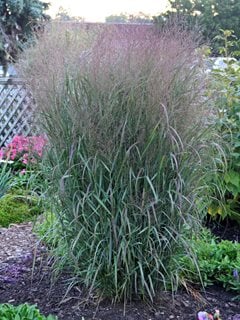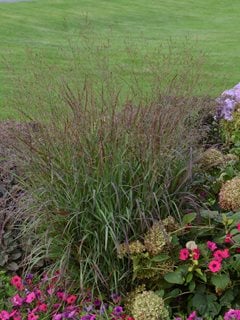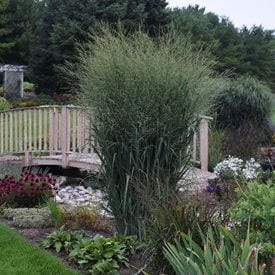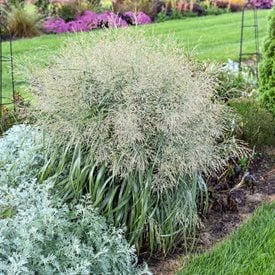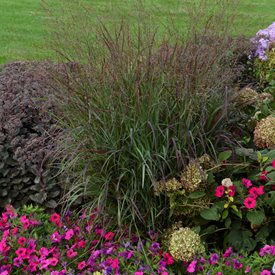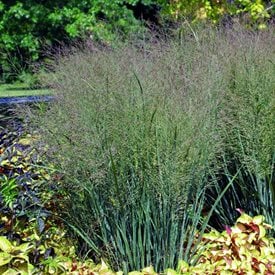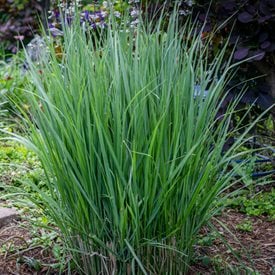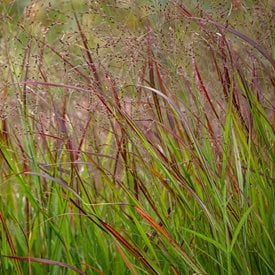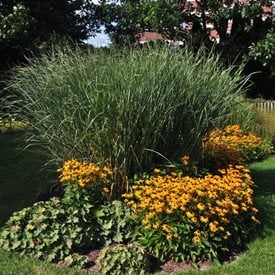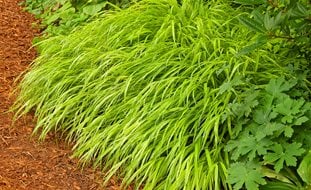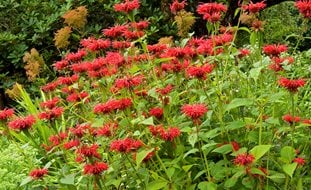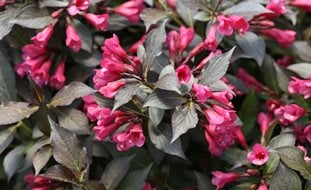How to Grow and Care for Switchgrass
This adaptable ornamental grass has many possible uses in the landscape Published 1/19/2023Switchgrass is a perennial grass native to North America, and was once a dominant species of the tallgrass prairies that covered most of the Great Plains. Also known as panic grass, this plant is a food source for cattle and is being explored as a potential source of biofuel. The attractive appearance and ease of care also makes switchgrass a valuable addition to home and commercial landscapes.
This perennial warm-season grass occurs naturally in areas of the U.S. east of the Rocky Mountains, spanning from southern Canada to Mexico. Adaptable to a wide range of temperatures and growing conditions, switchgrass is tolerant of drought and wet soils, and is resistant to most pests and diseases. Switchgrass is virtually maintenance-free once established and a versatile design element in the landscape, adding multi-seasonal color, texture and movement to beds, borders, and containers. Here’s how to grow and use switchgrass in your yard.
On this page: Basics | Planting | Care | Pictures | Landscaping with Switchgrass
On this page:
- SWITCHGRASS BASICS
- PLANTING SWITCHGRASS
- SWITCHGRASS CARE
- TYPES OF SWITCHGRASS
- LANDSCAPING WITH SWITCHGRASS
SWITCHGRASS BASICS
Botanical name:
Panicum virgatum
Plant type:
Switchgrass is a clumping perennial grass that spreads through rhizomes.
Zones:
4-9
Height/Spread:
3 to 8 feet tall, 1 1/2 to 5 feet wide
Exposure:
Full sun to part shade
Bloom time:
Mid to late summer
Growth habit:
Plants have a dense upright, arching, or vase-shaped habit
Foliage:
Strappy blade-like leaves come in shades of olive green, blue-green, or metallic blue. Foliage turns bright yellow or golden in fall, fading to tawny brown, lending color and structure in the winter landscape.
Flowers:
Airy flower spikes rise a foot or two above the foliage, the delicate panicles creating a cloud-like effect. Flowers are pink, dull purple, or gold, fading to tan in fall, with seed heads lasting into winter.
Benefits and other attributes:
Seeds are a food source for songbirds and other wildlife, while the dense growth provides shelter and nesting habitat. Switchgrass is also a host plant for some types of butterflies. The foliage rustles in the slightest breeze, creating sound and movement in the landscape. Plants may self-sow, but do not come true from seed.
Is switchgrass toxic?
Switchgrass is generally regarded as safe for pets and children. The ingestion of any ornamental plant may cause mild digestive upset. This grass is used as cattle feed but can be toxic to horses, goats, and sheep.
Is switchgrass deer resistant?
Switchgrass is considered deer resistant, though some deer damage may occur if other food sources are scarce.
PLANTING SWITCHGRASS
When to plant:
Switchgrass is a warm-season grass, emerging from dormancy in mid to late spring when the soil has warmed. In cold short season climates, plant in spring to allow new plants to establish roots. In warmer regions, plant switchgrass during cooler months in spring or fall to avoid transplant shock from extreme summer heat.
Where to plant:
Switchgrass grows best in a site that receives at least 6 hours of direct sunlight. Too little light can result in drooping stalks, poorly formed clumps, and weak growth.
How to plant:
Loosen soil in the planting area. Allow enough room for the deep root system to develop.
Dig a hole twice as wide and deep as the root ball. Remove plant from the nursery container and loosen roots if potbound. Place in the hole so the top of the root ball is level with the surrounding soil. Fill in the hole with soil, tamp down gently to remove air pockets, and water thoroughly. Water regularly until established.
SWITCHGRASS CARE
Soil:
Switchgrass is adaptable to most soils, but prefers moist, sandy or clay soil with a slightly acidic to neutral pH between 5.5 and 7. Soil that is too rich can result in plants falling over. For containers, use a high quality all-purpose soil mix.
Amendments and fertilizer:
Switchgrass needs little or no supplemental fertilizer. Soil that is too high in nutrients can cause plants to flop.
Water:
Water new plants regularly until established. Switchgrass is drought-tolerant once established and can also tolerate wet soils. For optimal growth, keep soil evenly moist but not soggy.
Pruning switchgrass:
Leave plants and seed heads through winter to provide food and shelter for wildlife. In late winter to early spring, cut the previous year’s growth back to the ground before plants break dormancy.
Dividing:
Switchgrass should be divided every few years, as the center of the plant may die out. This will also improve plant vigor. Divide in spring to allow roots to establish through the growing season.
Pests and diseases:
When given the right growing conditions, switchgrass is resistant to most pests and diseases. Pests can include aphids, Japanese beetles, leafhoppers, spider mites, or thrips. Too much water or humidity can result in fungal diseases such as anthracnose, leaf spot, rust, smut, crown or root rot.
SWITCHGRASS VARIETIES
LANDSCAPING WITH SWITCHGRASS
There are many ways to use switchgrass in your landscape. Here’s how:
For borders and landscapes: Plant in beds, borders, water gardens, natural areas, or along a stream, waterfall, or pond. Use as screening, in mass plantings, or as a background element in a mixed border.
For slopes and hillsides: Switchgrass can be massed along a slope or hill to control erosion.
For containers: Small to medium-sized specimens can be planted in containers, by themselves or alongside other plants with similar growing needs.
- Create a waterwise landscape using switchgrass and other drought-tolerant plants such as penstemon, blanket flower (Gaillardia), fescue, catmint, aster, and Russian sage.
- Naturalize switchgrass in a meadow garden alongside other prairie natives such as bee balm, blazing star (Liatris), little bluestem (Schizachyrium), milkweed, purple coneflower, black-eyed Susan, sunflower, and sedges.
- Mass along a slope, hillside, or berm to allow the deep root system to stabilize the soil.
- Combine a smaller variety in a container alongside coleus, creeping Jenny, dusty miller, lantana, mums, sedum, sweet potato vine, or zinnias.
- Plant in a mixed border as a vertical element to contrast with more rounded plants such as allium, catmint, coral bells (Heuchera), blue oat grass, hardy geranium, stonecrop, and tickseed (Coreopsis).
- Mass near a bog, stream or pond to provide food and shelter to visiting songbirds and other wildlife. See more on how to attract wildlife to your garden.
- Plant a larger variety in a row to screen out an unsightly view, or to soften a fence or property line.
- Plant in a rain garden alongside other moisture-tolerant plants such as bee balm, button bush (Cephalanthus), cardinal flower (Lobelia), joe pye weed, obedient plant (Physostegia) and rose mallow (Hibiscus).
- Embellish a curbside strip with switchgrass and other plants native to your area for a low maintenance landscape.
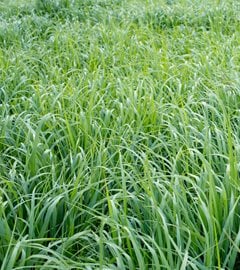
Photo: Olexandr Panchenko / Shutterstock.
SWITCHGRASS AS A BIOFUEL
In recent years, switchgrass has shown promise as a renewable energy crop for the production of biofuel. Because switchgrass can tolerate a wide range of growing conditions and needs little soil amendment or fertilizer, this highly adaptable plant can be cultivated in places that aren’t able to support other crops. The side benefits of switchgrass crops are the ability to control erosion and providing habitat for wildlife.
Plant-based sources of renewable energy are a climate-friendly alternative to fossil fuels. Biofuels are renewable at a much faster rate than coal or oil, generating lower carbon dioxide emissions. Once harvested, biofuel crops are used in the production of ethanol, for heating and to create electricity.
